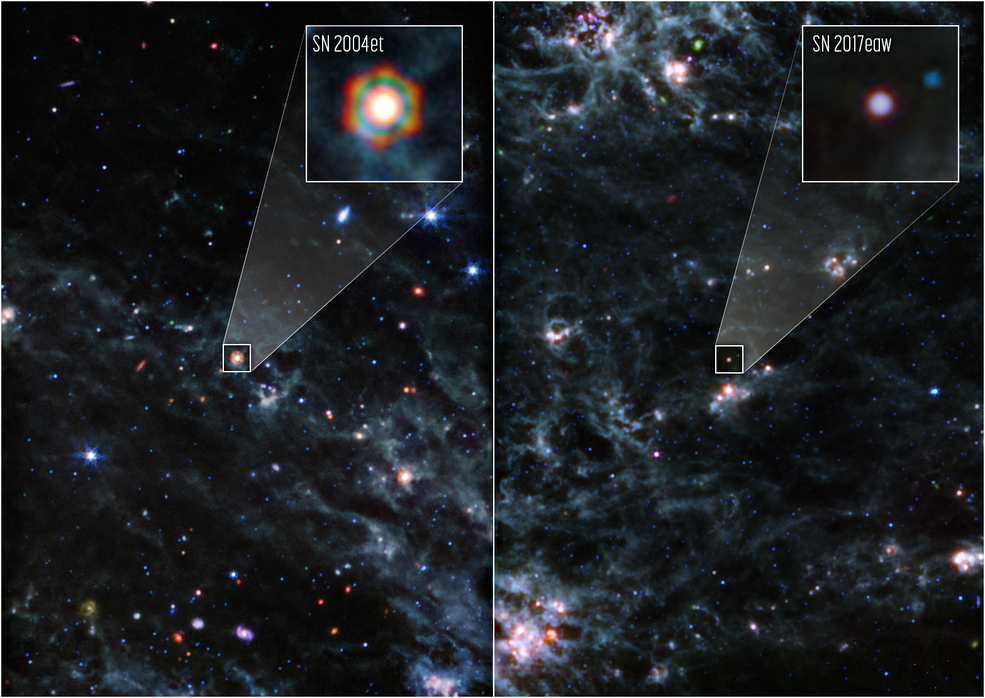Reviewed by Tibor BicskeiJul 6 2023
The source of dust in early galaxies has been confirmed by researchers using NASA’s James Webb Space Telescope. Large amounts of dust have been found in the ejecta of both Supernova 2004et (SN 2004et) and Supernova 2017eaw (SN 2017eaw), two Type II supernovae that have been observed. The mass discovered by researchers lends credence to the idea that supernovae were crucial in feeding the early universe with dust.

Images from NASA’s James Webb Space Telescope reveal large amounts of dust within Supernova 2004et and Supernova 2017eaw. These supernovae are located in spiral galaxy NGC 6946, 22 million light-years away from Earth. The hexagonal shape of SN 2004et in Webb’s image is an artifact of the telescope’s mirror and struts—when the bright light of a point source is observed, the light interacts with the sharp edges of the telescope, creating diffraction spikes. In these images, blue, green, and red were assigned to Webb’s MIRI data at 10; 11.3, 12.8, and 15.0; and 18 and 21 microns (F1000W; F1130, F1280W, and F1500; and F1800W and F2100W, respectively). Image Credit: NASA, ESA, CSA, Ori Fox (STScI), Melissa Shahbandeh (STScI), Alyssa Pagan (STScI)
Dust is a component of many objects in the universe, including planets. As dust from dying stars spreads through space, it carries vital components that will aid in the formation of the next generation of stars and planets.
For decades, astronomers have been perplexed as to where that dust comes from. Supernovae could be a key source of cosmic dust; after the dying star explodes, the residual gas expands and cools, creating dust.
Direct evidence of this phenomenon has been slim up to this point, with our capabilities only allowing us to study the dust population in one relatively nearby supernova to date—Supernova 1987A, 170,000 light-years away from Earth.
Melissa Shahbandeh, Study Lead Author and Postdoctoral Fellow, Space Telescope Science Institute
That combination of wavelength coverage and excellent sensitivity can only be reached with Webb’s MIRI (Mid-Infrared Instrument) for supernovae more distant than SN 1987A, such as SN 2004et and SN 2017eaw, both in NGC 6946, approximately 22 million light-years away.
The Webb findings represent the first significant advances in the study of supernova dust formation since the discovery of newly generated dust in SN 1987A with the Atacama Large Millimeter/submillimeter Array (ALMA) telescope nearly a decade ago.
The amount of dust observed at this early point in the supernova’s life is another especially exciting conclusion of their research. The researchers discovered around 5,000 Earth masses of dust in SN 2004et.
When you look at the calculation of how much dust we’re seeing in SN 2004et especially, it rivals the measurements in SN 1987A, and it is only a fraction of the age. It’s the highest dust mass detected in supernovae since SN 1987A.
Ori Fox, Program Lead, Space Telescope Science Institute
Astronomers have discovered that young, distant galaxies are densely packed with dust, but these galaxies are not old enough for intermediate-mass stars like the Sun to supply the dust as they age. More massive, short-lived stars could have died quickly and in sufficient numbers to produce that much dust.
While astronomers have proven that supernovae emit dust, the question of how much of that dust can survive the internal shocks that reverberate in the aftermath of the explosion has remained unanswered.
Seeing this much dust at this point in the lives of SN 2004et and SN 2017eaw demonstrates that dust can survive the shockwave, proving that supernovae are, after all, essential dust producers.
The current mass estimates could represent the top of the iceberg, according to researchers. While Webb has made it possible to measure particles cooler than ever before, the outermost layers of dust could continue obscuring the presence of undetected, colder dust that radiates even further across the electromagnetic spectrum.
The new discoveries are only the first indication of newfound research capabilities into supernovae and their dust creation using Webb and what that can reveal about the stars from which they originated, the researchers noted.
Fox added, “There is a growing excitement to understand what this dust also implies about the core of the star that exploded. After looking at these particular findings, I think our fellow researchers are going to be thinking of innovative ways to work with these dusty supernovae in the future.”
The first two of the program’s five aims are SN 2004et and SN 2017eaw. Webb General Observer program 2666 was used to complete the observations. On July 5th, 2023, the study was published in the Monthly Notices of Royal Astronomical Society.